Private Label Rights (PLR) licenses let you purchase, modify, rebrand, and resell digital products created by someone else. Learn how PLR works, how it differs from other licensing models, and how to use it to generate passive income.
Key takeaways
- PLR allows buyers to modify, rebrand, and resell digital products under their own brand.
- The global PLR market is expected to reach $1623.4 billion by 2034.
- PLR ebooks typically cost $10-$50 and can generate $100-$10,000+ monthly in earnings.
- Unlike resale rights, PLR provides maximum customization freedom for product modifications.
- Successful PLR selling requires active branding, audience building, and product promotion efforts.
Looking for an opportunity that can grow from a side hustle to a regular, passive income?
You’ll need two things: a product to sell, and a shortcut to avoid burning out.
Enter Private Label Rights. PLR saves sellers both time and effort, allowing you to start making money without any extensive labor.
Let’s get into it.
What is PLR?
Private label rights, or PLR, refers to a licensing model that lets you purchase pre-made digital products, modify them, and resell them under your brand or business.
The point is that PLR products can be edited, customized, and branded as if they were your own. Think ebooks, courses, templates–the list goes on.
Why choose a PLR product? Well, one of the most attractive features of PLR is the time and effort it saves you.
Rather than starting from scratch, you’re working with an existing product.
So, anyone can become a course builder or an ebook author. Plus, saving time lets you focus on personalizing and marketing the product.
Basically, PLR streamlines the whole process of building and scaling a digital business.
What's the difference between PLR, resale rights, and master resale rights?
PLR isn't the only kind of digital product license available, but it is the most flexible.
If you’ve heard of resale rights and master resale rights, you might be scratching your head over the difference between each term.
While they all sound similar, each license type offers different levels of customization and potential for profit.
I've popped a quick table here to compare the three, but you'll find detailed explanations below.
| License Type | What You Can Do | Pros | Cons |
| Resale Rights |
Sell the product as-is; no modifications or rebranding allowed. |
Quick start for beginners; easy to start selling without creating content. |
Limited branding opportunities; difficult to stand out; many sellers offer the same product. |
| Master Resale Rights |
Sell the product and give your buyers the right to resell it themselves. |
Can create a network of sellers, increasing potential reach and sales. |
Reduces competitive edge; can be seen as pyramid-like; market saturation risk. |
| Private Label Rights (PLR) |
Modify, rebrand, and customize the product; add or remove content. |
Maximum flexibility; create unique products; build brand and USP; higher profit potential. |
Requires time and effort to modify content; quality depends on your work. |
Resale rights
When you purchase a product with resale rights, you’re allowed to sell the product as-is only.
So you can offer your customers the product, but can’t alter its content or branding. You're basically a middleman, offering the product in its original form.
For beginners, resale rights can help you start selling digital products quickly; however, building a brand or sustainable business through this method alone can be hard.
Offering the same generic product as many other sellers can make it harder to stand out online.
Master resale rights
Master resale rights allow you to sell a product and simultaneously grant resale rights to your customers.
In other words, not only can you sell the product, but you can also let your buyers sell it themselves.
This can create an extended network of sellers promoting your product, increasing sales.
However, it also takes away from your competitive edge. Plus, master resale rights can be seen as a pyramid scheme of sorts, and so is looked upon unfavorably by certain buyers.
Private label rights (PLR)
This brings us to private label rights (PLR), which provide you the most freedom.
As mentioned above, with PLR, you modify the base content, rebrand it, and add or remove material.
With this level of customization, you’re more likely to create a product with a USP that resonates with your target audience.
PLR means you’re not just reselling an existing product but transforming it into something valuable and leaving your own mark.
Oh, and now's a good time to cash in. The global PLR market is expected to reach $1623.4 billion by 2034.
5 examples of PLR digital products
Here’s a look at some of the most popular types of PLR digital products and how you can use them to start selling:
1. Ebooks
Ebooks are one of the most commonly sold PLR products.
A huge benefit of ebooks is that they can cover virtually any topic, from self-help and personal development to niche-specific guides.
With PLR ebooks, all you have to do is modify the content to add your own information, insights, and brand.
You can make simple, minimal edits or purchase a PLR ebook as an outline to create something entirely new.
Personal trainers could purchase a PLR ebook on nutrition, add their own workout routines, and sell it as a comprehensive health guide.
- Cost: PLR ebooks usually range from $10-$50 per title, depending on quality and length.
- Earning potential: Sellers can make $100-$10,000+ per month, depending on marketing, audience size, and pricing strategy.
2. Social media templates
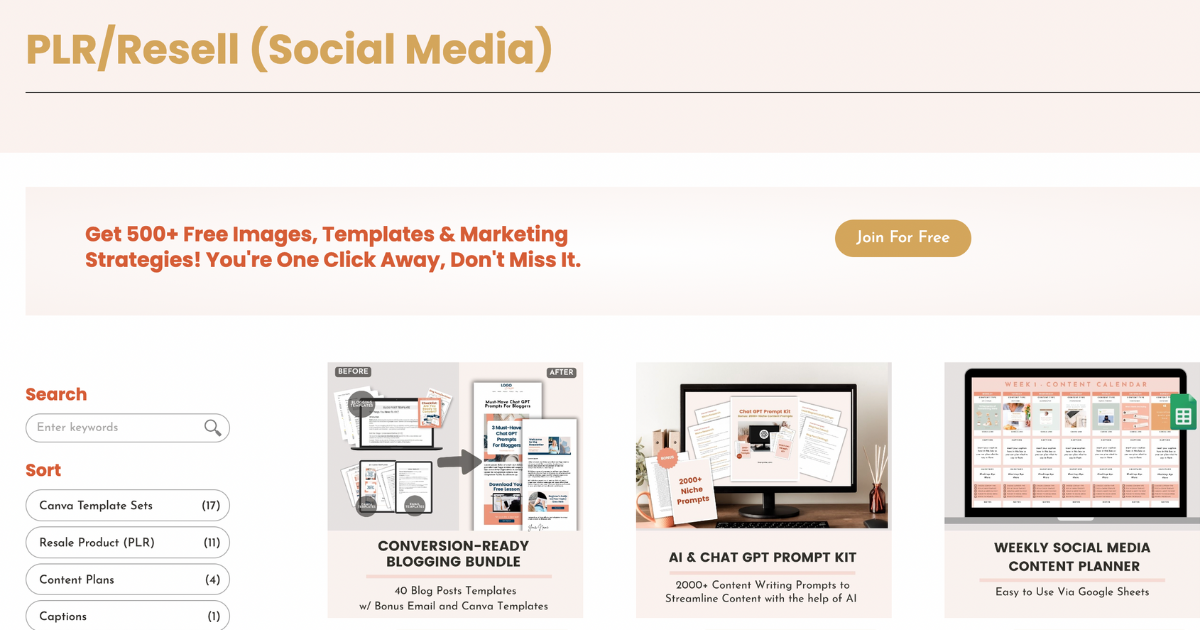
Not everyone 'gets' socials, but every business needs a social media presence.
Social media templates are a popular digital product, as they allow anyone to create consistent and on-brand content for their business.
By selling PLR templates, you can tap into this market without any extensive experience in design or social media and begin selling templates right away.
- Cost: PLR social media templates typically cost $15-$60 per pack.
- Earning potential: Sellers can make $50-$5000+ per month, depending on how many templates are sold and if you bundle them creatively.
3. Online courses
If you’ve dreamed of building an online course, PLR offers a unique opportunity to provide educational content without the need to develop it from scratch.
As with any PLR product, the more value you add, the better. You can (and should) customize the course material, add your own modules, and even create extra, interactive elements like quizzes or assignments.
Just getting into digital products? Buying a PLR course can help you understand how course-building works and gain the confidence to build your own from scratch.
- Cost: PLR online courses range from $50-$300 per course, depending on length and quality.
- Earning potential: $200-$10,000+ per month is achievable depending on pricing, marketing, and audience reach.
4. Planners
A recent ECAL survey found that 70% of adults in the US use a digital calendar or planner, so that's a market worth looking at.
Buying a PLR journal model allows you to modify and create various products from one, such as daily, weekly, or monthly planners.
You can theme them towards certain demographics, such as health and wellness or creative projects.
You could create a productivity planner with PLR content and add your own motivational quotes, imagery, and tips to cater to a niche audience.
- Cost: $10-$40 per PLR planner.
- Earning potential: $50-$5000+ per month, depending on how many copies you sell and whether you offer bundles.
5. Journals
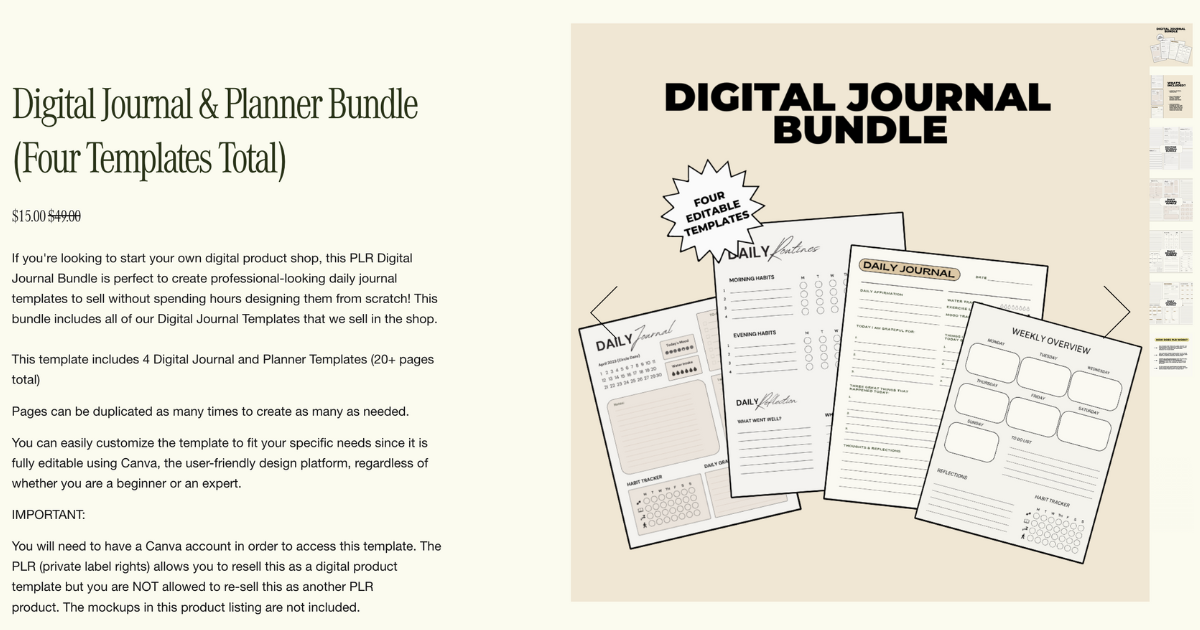
Similar to planners, PLR journals can be tailored to suit various purposes, from gratitude to goal-setting.
Purchase the base model, saving you extensive time, and get straight to personalizing with prompts, designs, and branding.
If your target audience focuses on personal development, you could use PLR journals to create a self-reflection journal, complete with unique exercises and inspirational content.
- Cost: $10-$50 per PLR journal.
- Earning potential: $50-$5000+ per month, based on marketing and audience size.
Making money with PLR: How easy is it, and how much can I earn?
Let’s cut to the chase: how much money can you really make with PLR? As shown above, earnings depend on the type of product, how much you charge, and your marketing.
A well-targeted ebook or online course can bring in hundreds, thousands, or even tens of thousands of dollars each month.
Social media templates, planners, and journals can also be profitable, especially if you bundle them or release seasonal editions.
But remember, success requires effort: you need to build a brand, grow an audience, and actively promote your products.
Here’s a quick 3-step approach:
1. Source your PLR digital product
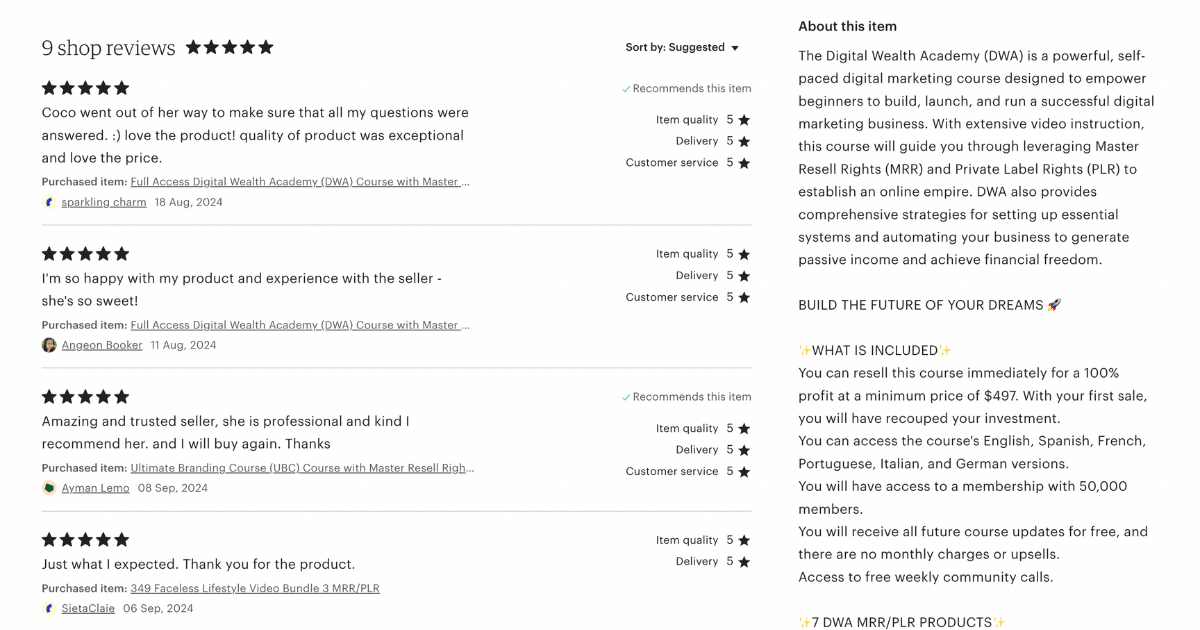
Your first step? To find a reliable PLR provider. Check reviews, sample content, ratings, and any support options.
High-quality products with clear previews give you the best chance of success, and any products that include support from the creator are even better.
2. Make your edits
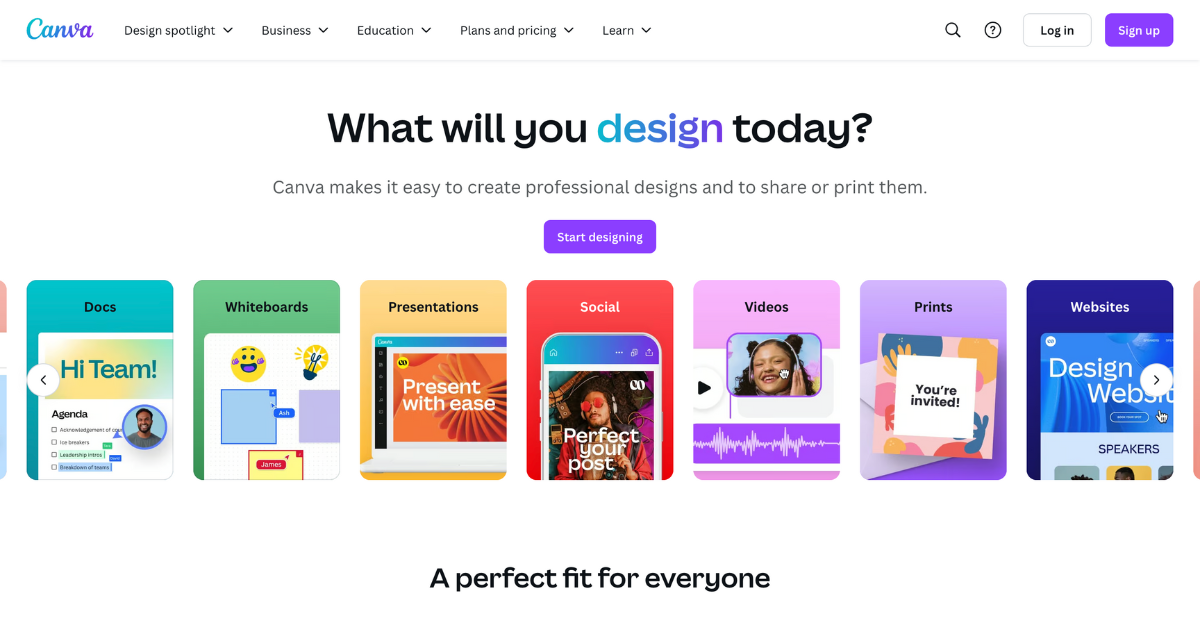
After acquiring your PLR product, the next step is to start personalizing.
Update text, add branding, or create new sections.
For social media templates or planners, adjust visuals to match your style. For ebooks, add value to the written content.
Tools like Canva or Photoshop make customization easy.
3. Upload to your store or marketplace and start selling
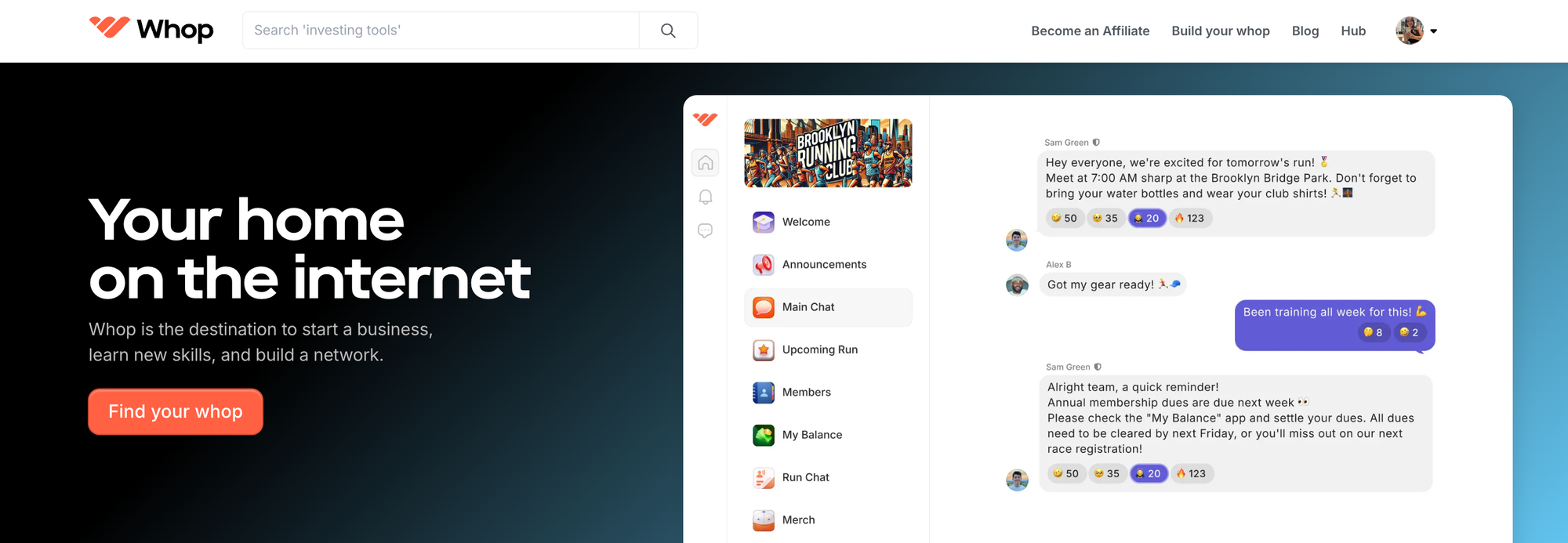
Once ready, upload your product to a store, marketplace, or ecommerce platform.
Make sure you write clear descriptions, add visuals, and highlight benefits.
You can promote PLR the same way as any digital product: through social media, email, or other channels.
Platforms like Whop also let you build communities, answer questions, and do live demos.
Here's a quick table overview of some popular platforms for comparison:
| Platform: | You can sell: | Fees: | Ease of use: | Marketplace: | |
| Whop |
Ebooks, courses, templates, memberships, communities, software |
2.7% per sale; no monthly fees |
Super beginner-friendly; fast setup |
Built-in marketplace with loyal users |
|
| Gumroad |
Ebooks, downloads, subscriptions, memberships |
10% + $0.50 per sale for direct sales; 30% flat fee for discovery sales via Gumroad.com; no monthly fees |
Simple setup, but limited customization |
Small marketplace exposure |
|
| Etsy |
Digital downloads (printables, planners, templates) |
$0.20 listing fee + 6.5% transaction fee + payment processing fee (3% + $0.25) |
Moderate; needs strong branding |
Large marketplace, but crowded |
|
| Podia |
Courses, memberships, downloads |
$39/month (Mover plan) + 5% transaction fee |
Easy interface |
No real marketplace |
|
| Shopify |
Anything digital (via apps) |
$29/month + transaction fees unless using Shopify Payments |
Steeper learning curve |
No built-in marketplace |
Whop’s Merch app lets you sell physical items alongside PLR offerings. A rebranded fitness course could be paired with physical hoodies, water bottles, or journals – all managed and sold within the same platform.
This way, you’re not limited to digital sales and can grow multiple revenue streams with minimal extra effort.
Creating and selling your own products with resale rights
Once you’re comfortable with PLR, you can create your own products with resell rights.
For example, you might develop a comprehensive course on a specific topic, package it with resale rights, and offer it to other entrepreneurs who want to sell it.
By creating and selling products with resale rights, you’re not just generating income from your own sales. You can benefit from a network of sellers promoting your products, too.
Your reach and sales potential grow as other sellers distribute and market your products in their own channels.
The pros and cons of selling PLR products
As with any online hustle, selling PLR products comes with its own set of advantages and challenges.
| Pros | Cons |
|---|---|
| Time-saving | Competition can be higher |
| Less labor-intensive | Variability in PLR product quality |
| Cost-effective | Originality |
| Flexible | Reliance on external content |
| Opportunities for growth | Licensing understanding is crucial |
| Allows anyone to sell a course, ebook, etc. | Potential bias |
Selling PLR products has obvious benefits:
- Time saving: Since the content is already made, you can skip the long development process.
- Cost-effective: PLR products are also usually pretty cheap, making it easy to start selling without a big upfront investment.
- Flexible: You can modify and rebrand PLR products to match your style and audience, which helps your product stand out in a crowded market.
On the flip side, there are some drawbacks:
- Competition: PLR products are sold to multiple buyers, so to stand out, you need to add your own twist, insights, or extra value.
- Quality can vary: some PLR products are low-quality or outdated, so picking reputable sources is essential.
Weighing up these pros and cons can help you better decide whether PLR is right for you or if you’d rather build your own digital products from scratch.
Sell any PLR digital products with Whop
Whop makes it easy to profit from PLR.
You can sell almost any type of digital product (ebooks, online courses, templates, social media packs, digital planners, and more) all from one platform.
And when you launch your own Whop hub, you’re not just selling products – you’re also building a community around them.
Rebrand a PLR course, and you can set up a community chat alongside it to keep buyers engaged, answer questions, and increase long-term value.
We'll handle the technical side so you stay focused on customizing, building, and growing.
Start selling PLR with Whop today and see how easy it is to make passive income online.
Legal considerations when selling PLR digital products
Before you start selling PLR, it’s pretty important to understand the legal side.
PLR products save time and give you ready-made content, but they also come with rules around licensing, copyright, and resale.
Knowing these basics will help you stay compliant, protect your business, and avoid headaches down the line.
- Licensing terms: Always check the specific license attached to your PLR product. Some allow full edits and rebranding, while others restrict modifications.
- Copyright issues: Only buy PLR from reputable sources. Poorly sourced products may contain copyrighted material, putting you at legal risk.
- Resale rights: Resale and master resale rights aren’t the same as PLR. Make sure you understand what you can and cannot do before selling.
- Consumer protection: Be transparent about your product. Misleading claims or failing to disclose PLR origins could breach consumer protection laws in some regions.
This is general guidance only. Always consult qualified legal and tax professionals for advice specific to your situation, especially before launching high-revenue products or expanding internationally.
FAQs
What is the difference between PLR and other types of resale rights?
PLR (private label rights) allows you to modify and rebrand a product before selling it, giving you flexibility to make it unique to your brand.
Resale rights only permit you to sell the product as-is, while master resale rights let you sell the product and grant resale rights to others.
So basically, PLR is the only option that offers both personalization and customization.
Can I use PLR content for my blog or website?
Sure, but it’s important to customize to ensure the content aligns with your brand and provides value to your audience.
Always edit PLR content and add your own insights, update information, and incorporate your brand’s voice.
Customized PLR content can enhance your online presence and improve engagement, while generic PLR content can do quite the opposite.
How can I ensure I purchase quality PLR products?
Firstly, make sure to purchase content from reputable providers known for their high standards.
Head to the review sections of each listing to see what people are saying (and if the reviews seem genuine). Once you purchase your product, thoroughly review and edit the content to improve its quality and make it suitable for your audience.
Quality control is pretty important when you're dealing with PLR products.
Are there any restrictions on selling PLR products?
Most PLR products have broad usage rights, but restrictions can vary depending on the license terms.
Some PLR licenses may prohibit you from giving away the product for free, or they may limit how you can distribute it.
To be on the safe side, always review the license agreement associated with each PLR product to understand any restrictions or conditions.
If you don’t understand a term or condition, it pays to do some research.
How can I market PLR products effectively?
Marketing any digital products means getting clear on your buyers, and PLR is no different.
Create a compelling product listing with clear descriptions and attractive visuals that speak to your target audience. Then use social media, email, and content marketing to reach them.
Consider offering promotions, bundles, or limited-time offers to attract buyers.
Which PLR products are trending in 2025?
The hottest PLR products right now include AI-powered tools, prompt packs, automation hacks, and niche products that hit big communities like wellness, remote work, and sustainability.
Oh, and quick-win stuff (like Canva templates, social media kits, and bite-sized online courses) is always popular, since it's easy to flip, rebrand, and resell fast.



